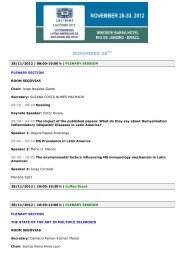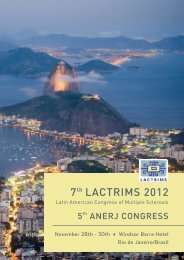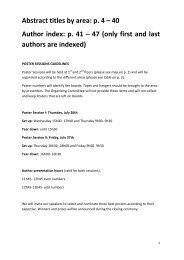Keynote Conference - Interevent
Keynote Conference - Interevent
Keynote Conference - Interevent
You also want an ePaper? Increase the reach of your titles
YUMPU automatically turns print PDFs into web optimized ePapers that Google loves.
Symp #28 Cells as biosensors<br />
Chairs Glaucia M Machado Santelli and Paulo Saldiva<br />
Cytotoxic indole alkaloids isolated from Duroia macrophylla (Rubiaceae).<br />
Cecilia Veronica Nunez 1 *, Marne Carvalho de Vasconcellos 2 , Vincent Roumy 3 , Sevser Sahpaz 3 , François Bailleul 3 , Thierry Hennebelle 3 .<br />
1<br />
Laboratório de Bioprospecção e Biotecnologia, Coordenação de Tecnologia e Inovação, Instituto Nacional de Pesquisas da Amazônia,<br />
Aleixo, Manaus, Amazonas, 69060-001, Brazil;<br />
2<br />
Faculdade de Ciências Farmacêuticas, Universidade Federal do Amazonas – UFAM, Rua Alexandre Amorim, 330, Aparecida, Manaus,<br />
Amazonas, 69010-330, Brazil;<br />
3<br />
Laboratoire de Pharmacognosie, EA 4481, Université de Lille 2 – Droit e Santé, 59006, Lille, France.<br />
Duroia macrophylla Huber is a native plant species of the Amazon region. It is known as cabeça-de-urubú, apuruí or puruí-grande-damata<br />
but no medicinal use is described for it. In our research group bioprospection programm, we collected several Rubiaceae plant<br />
species, prepare organic and aqueous extracts and assayed to several activities. D. macrophylla extracts were first assayed against<br />
Artemia salina, to determine their toxicity. The methanolic leaf extracts was toxic against A. salina, with a LD50 of 40.00 µg/mL. Then,<br />
the methanolic leaf extract was fractionated and 4 alkaloids were isolated: two new roxburguine indole alkaloids plus two other<br />
known ones. All isolated substances were essayed on tumor cell lines and the new alkaloid 4 showed a cytotoxic activity against HL60<br />
(human leukemia), APC02 (human gastric adenocarcinoma) and B16F10 (murine melanoma) tumor cell lines (IC50 values of 2.28<br />
µg/mL, 5.08 µg/mL and 5.11 µg/mL, respectively) and a cytotoxicity of 7.8 µg/mL on normal cell line NHI3T3 (fibroblast murine). The<br />
alkaloids assayed did not cause membrane disruption in mouse erythrocytes. This is the first chemical study on this species. Our<br />
findings showed that Amazonian plant species can contain new active substances, even if they do not have popular use.<br />
Acknowledgments: CT-Agro/CNPq, PPBio/CNPq, FAPEAM, INCT - CENBAM/CNPq.<br />
Cell-fiber interactions: effects on cell biology<br />
Glaucia Maria Machado-Santelli<br />
(glaucia.usp@gmail.com) Department of Cell and Developmental Biology Institute of Biomedical Sciences - University of São Paulo,<br />
Brazil<br />
Particle toxicology main subject is to understand their cytotoxic and genotoxic mechanisms. Initial studies focused on the evaluation<br />
of particles parameters after inhalation such as the diameter, length and biopersistence led to the association of asbestos exposure<br />
with several health problems including lung cancer and mesothelioma. The low biopersistence of chrysotile, causing it to disintegrate<br />
and become shorter in the lungs, is the main structural features that lead the chrysotile being less pathogenic than the amphiboles.<br />
This safety has been controversial since in vitro chrysotile-associated genotoxic potential has been demonstrated. We evaluated the<br />
induction of micronucleated, poliploid and multinucleated cells in chrysotile exposed cultured cells. These in vitro studies show that<br />
fibers interfere with mitoses and cytokinesis progression leading to multinucleated and polyploid cells. Cell cycle progression is<br />
impaired by fibers and multipolar mitosis may be consequence of fiber induced centrosomic amplification. The cell fate was followed<br />
by pulse-time microscopy, allowing us to establish how the chrysotile treatment acts on cell cycle progression and its possible<br />
relation with other types of fibers.<br />
Cellular responses to ambient levels of air pollution<br />
Paulo Saldiva<br />
(pepino@usp.br) Department of Pathology Faculty of Medicine – University of São Paulo, Brazil<br />
The widespread use of fossil fuels has been associated to marked alterations in our environmental. Global climate changes and local<br />
air pollutants are known to cause adverse health effects in humans. The use of cells as biosensors of adverse effects have provided<br />
valuable information for the process of evaluating environmental risk associated to air pollution. Respiratory epithelium,<br />
endothelium, placental trophoblast, cells of seminiferous tubules, endometrium, and cells of reproductive organs of higher plants<br />
have been extensively used to detect, quantify and explore the mechanisms of pollution induced injury, disclosing new perspectives<br />
to the process of pollution control, aimed to preserve human health. Effects of air contaminants such as endocrine disruption,<br />
cardiovascular damage, cancer induction and promotion and persistent inflammation, have been characterized using cellular systems<br />
or in vivo toxicological approaches. In this context, biomonitoring of air pollution is nowadays as important as the classical chemical<br />
characterization of the concentration of environmental toxics, opening new areas of research in cell biology.<br />
80





